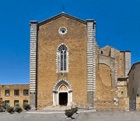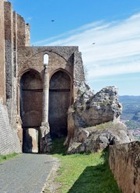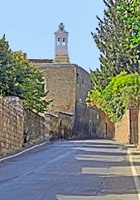

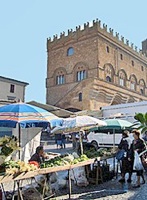
Ranieri della Greci ordered the building of the Palazzo del Popolo here in 1281 to house the newly dominant magistracy of the Popolo. He demolished a number of properties in front of it, [including the monastery of Santa Croce] to create a new civic space that counter-balanced:
-
✴Piazza del Duomo - see Walk I and
-
✴Piazza Maggiore (now Piazza della Repubblica) - see Walk II.
Today, the piazza has a disappointingly run down appearance, although it comes to life on Saturdays, when the parked cars are moved away for the weekly market.
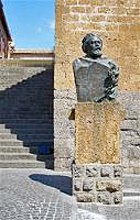

Proceeding in a counter-clockwise direction, Palazzo Simoncelli dominates the west end of the piazza.
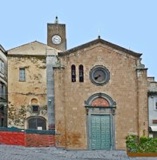
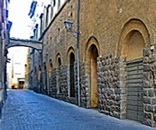
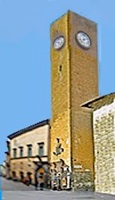
San Rocco Right side of Palazzo dei Sette Torre del Moro
in Piazza del Popolo in Via della Costituente and main wing of palace
in Corso Cavour
San Rocco stands in the middle of the south side of Piazza del Popolo, at the corner of Via della Costituente. This church formed part of the complex of the Palazzo dei Sette, the third public palace of Orvieto, used by the magistracy of seven representatives of the trade guilds known as the Signori Sette . Take a short detour by turning right along Via della Costituente, which runs along the right side of this L-shaped palace. Continue to the junction with Corso Cavour to see what was the Torre Civico (now known as Torre del Moro), with the second wing of Palazzo dei Sette beyond.
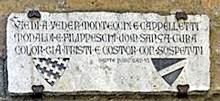
The inscription on the corner of Via della Costituente quotes from Dante's “Divine Comedy” (Canto VI, 106-7):
Come and behold Montecchi and Cappelletti, Monaldi and Fillippeschi, careless man!
Those sad already and those doubt-depressed!
Thus the Monaldeschi and Filippeschi of Orvieto, like the Montecchi and Capuleti of Verona, suffer in Purgatory and provide a warning to the cruel.
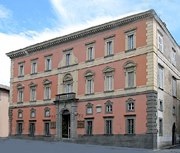
Return to Piazza del Popolo and turn right to continue the counter-clockwise circuit, past Palazzo Bracci (Hotel Reale).
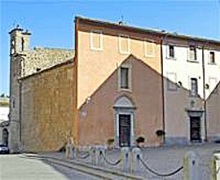
Continuing the circuit, the de-consecrated churches of San Bernardo and San Carlo Borromeo stand next to each other behind a common facade at the east end of the piazza.
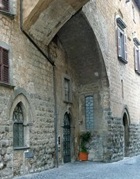
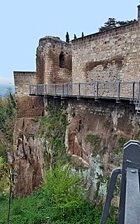
You can continue down the path to the necropolis of the Crocifisso del Tufo, although you can alternatively visit the necropolis as part of Walk IV. If you decide to do it now, walk down the steep path that was recently built to allow tourist access to it. Before returning up the path, detour right along it to see the Cappella del Crocifisso del Tufo to see the crucifix carved into the tufa for which the chapel and necropolis are named.
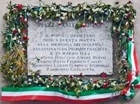
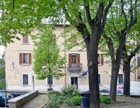
Take a short detour by continuing along Via Arnolfo di Cambio/ Via Roma to the junction with the next street on the left. This street (which is now a cul-de-sac) leads to an area known as Vigna Grande, which was the site of an ancient temple now known as the the Tempio di Vigna Grande that no longer survives. This temple and the nearby Tempio del Belvedere (below) were outside the main urbanised area of Etruscan Volsinii.
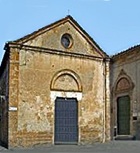
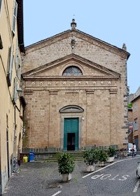
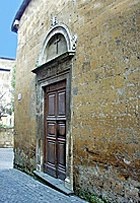
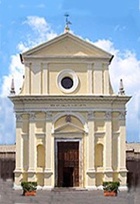
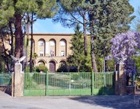
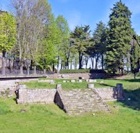
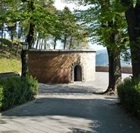
Continue to re-enter Piazza Cahen along the left side of the terminus of the funicular railway. The railway was designed by Adolfo Cozza in 1888 under the auspices of the mayor, Giacomo Bracci. The upper part of the track passes through a tunnel that was excavated under Rocca del Albornoz (see below). This original system, which was driven by water power, survived until 1970. The present electric system was inaugurated in 1990. (Electric buses from here run frequently to the city centre).
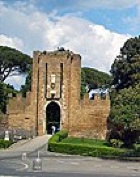
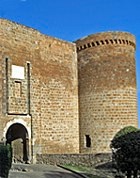
You can take a detour here of some 2.5 km to the Abbazia di SS Severo e Martirio. Turn left downhill on Strada Fontana del Lione, then right at the end along the main road. The first turning on the left takes you to the abbey (signed to the hotel, La Badia di Orvieto).
However, it is probably more convenient to take the alternative route set out in Walk IV, which returns to this point.
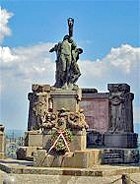
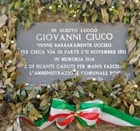
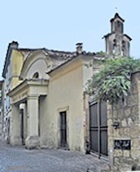
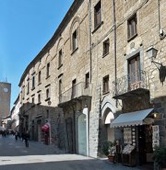
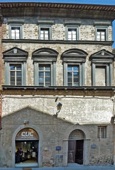
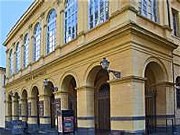
Palazzo Alberi Palazzo Petrucci Teatro Comunale
Turn left at the end along Corso Cavour.
-
✴Palazzo Petrucci is on the right (at number 149-51),
-
✴Palazzo Alberi is next to it (at number 129-47) and
-
✴Teatro Comunale is opposite (at number 122).
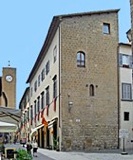
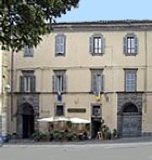
Palazzo Aureli-Missini Palazzo Febei
Piazza Fracassini opens up from Corso Cavour on the right:
-
✴Palazzo Aureli-Missini is in Piazza Fracassini (at number 117-25); and
-
✴Palazzo Febei is opposite (at number 98-104).
Continue along Corso Cavour and take the next turning on the right, along Via San Leonardo. The ancient church of San Leonardo stood between them until it was demolished in 1802. A number of architectural terracotta objects (ca. 400 BC) that were found in 1912 in a well here may well have come from the temple under the nearby Palazzo del Popolo.
Follow Via San Leonardo as it swings left, and continue into Piazza del Popolo, where the walk ends.
Return to Walks Around Orvieto.
